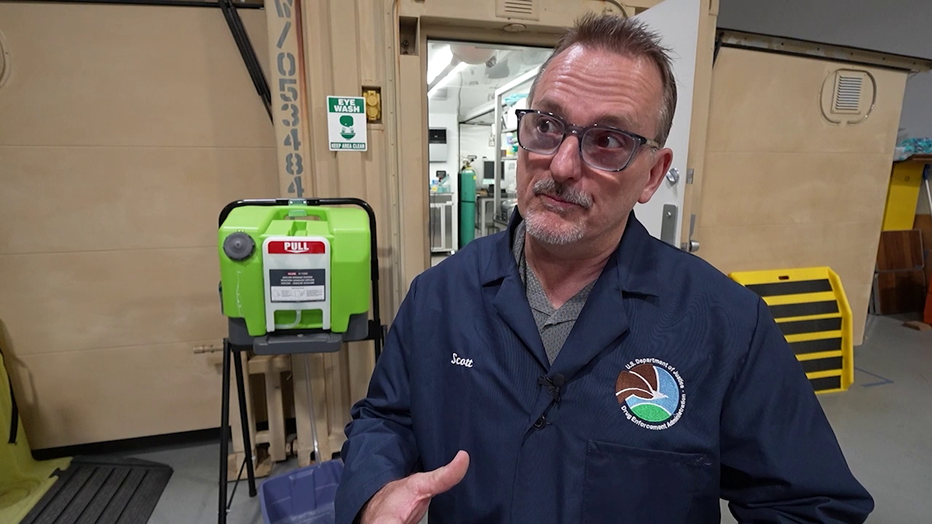DEA Phoenix: Industrial chemical keeps showing up in fentanyl supply, raising new concerns
PHOENIX - FOX 10 got exclusive access to a new Drug Enforcement Administration (DEA) mobile lab where massive amounts of illicit drugs are being tested daily.
The DEA Phoenix Division is tackling the flow of fentanyl and the newest substance that concerns the agency.
"This is pretty much a regular weekend, weekday here in Phoenix," Special Agent in Charge, Cheri Oz, says.
Oz shows what the reality is for the DEA in Phoenix on one table alone: 700,000 fentanyl pills and 200 pounds of meth.

"We know that seven out of ten of these pills contain a lethal dose. So, if you think about that, a thousand pills would fit in your pocket and I wouldn’t even know that they were on you. It could kill potentially 700 people," she said.
Oz says the drugs were sourced from the Sinaloa Cartel and seized by the DEA after just a few days.
How is this department combating drug trafficking in Arizona?
The Laboratory Analysis Response Center (LARC) is a new mobile lab designed to test the drugs seized by authorities. Before, agents in Phoenix had to mail or drive evidence to the DEA’s San Diego Division.
"We are the first mobile lab here in Arizona, here in Phoenix. Because it's so important for us to get the information right away. Just in June, we started seeing this BTMPS. It's a new compound that we're seeing looking like fentanyl pills, looking like M30 blue pills. We found it here in Arizona in June and by August, we had seized it in all of the United States," Oz says.

Special Agent in Charge, Cheri Oz
She said fentanyl seizures declined this past year, but BTMPS is being found more and more. BTMPS is an industrial chemical with no approved use for humans, according to the University of Washington.
The chemical is mainly used in plastic for protection against ultraviolet rays.
In a recent study by UCLA, the National Institute of Standards and Technology and other academic institutions, they discovered that in nearly 180 samples sold as fentanyl in L.A. and Philadelphia between June and the end of August of this year, roughly a quarter of them contained "BTMPS." Researchers say the presence of "BTMPS" in the illicit drug supply at this "speed and scale is unprecedented and concerning."
"We’re starting to see it in fentanyl submissions over the last several months, and we’re still doing some investigative work," says DEA Deputy Assistant Administrator Scott Oulton. "Is it there because it’s some type of re-agent or part of the manufacturing process? Or are they adding it intentionally to either increase or delay the effect in some form or fashion? We’re still trying to figure that out."
For the DEA, the LARC is the first of its kind here.

Starting as a pilot program in Arizona, the LARC became fully operational in March to respond to the fentanyl crisis.
Oulton takes us inside where scientists are testing traditional M30 pills. We watched them do analysis that reveals proof these fake pills contain fentanyl and BTMPS.
Oulton says whoever is producing the synthetic drugs is using "bucket chemistry," following their own set of dangerous rules.

DEA Deputy Assistant Administrator Scott Oulton
"These are not necessarily trained scientists. They are literally just following their recipe: two parts of this, one part of that and mix it, add some heat. It’s that simple these days," Oulton said.
And where there are pills, there’s probably powder. In this case, a whole kilogram of it.
We studied a brick of what is fentanyl and BTMPS. The symbol on it looks like a stag, and it can indicate who made this substance, who it’s meant for, or the purity of it. Or, simple marketing.

"This is their brand," Oulton said.
James Malone is the Laboratory Director for the DEA Southwest Lab. For his team, the LARC is a game-changer as Arizona is a gateway for drug trafficking.
"There’s a lot. The amounts seem to be significant. We handle some of the largest evidence here in the southwest border," he said.
For Malone and his team, it only makes sense to deploy this lab in Phoenix. They believe it’s about meeting the moment.
"We wanted to be as close as we could to the problem and part of it was to be able to analyze evidence right away, get the results to the agents and to be able to get the results out to the public," he adds.

James Malone, Laboratory Director for the DEA Southwest Lab
Further studies on BTMPS are "urgently needed," researchers say. They not only want to learn why it’s suddenly showing up in the fentanyl supply this past April, but also how it will affect those exposed to it.
It’s clear testing at the LARC will be crucial.
"And we’re seeing turnaround times in days, not months or six months. We’re seeing it in days," Oulton said.

